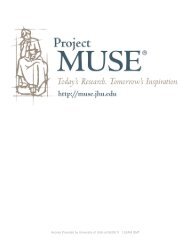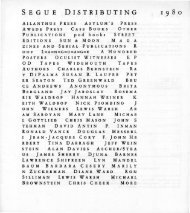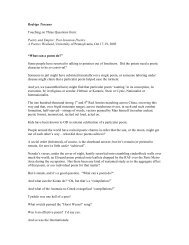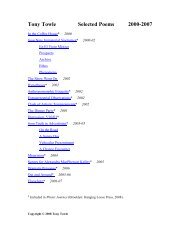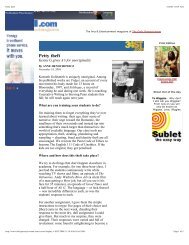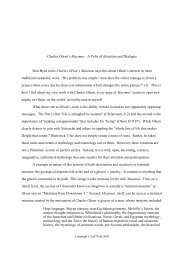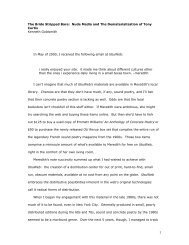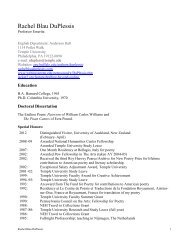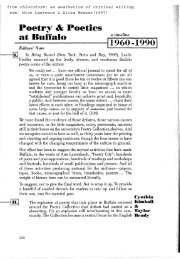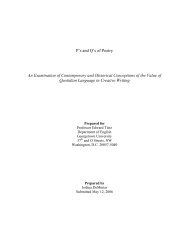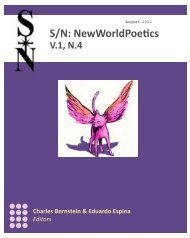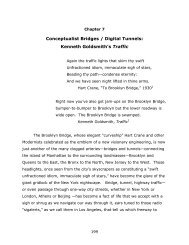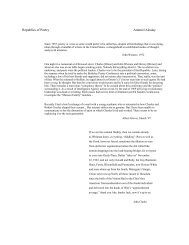'EASTER, 1916': YEATS'S FIRST WORLD WAR POEM
'EASTER, 1916': YEATS'S FIRST WORLD WAR POEM
'EASTER, 1916': YEATS'S FIRST WORLD WAR POEM
You also want an ePaper? Increase the reach of your titles
YUMPU automatically turns print PDFs into web optimized ePapers that Google loves.
FN:16<br />
232 marjorie perloff<br />
Tim Kendall chap12.tex V1 - October 4, 2006 1:50 P.M. Page 232<br />
his characters as actors playing out a script largely beyond their control, actors<br />
caught up in a street theatre in which their individual identities are subordinated<br />
to a larger communal drive, Easter itself symbolizing the power and possibility of<br />
wholesale renewal.<br />
Numerology plays an important part in the poem. ‘Easter, 1916’ has four stanzas<br />
of 16, 24, 16, 24 lines respectively, covertly embodying the Rising’s date—the<br />
twenty-fourth day of the fourth month of the year 1916—even as its metre offsets<br />
these multiples of four with a trimeter or, more properly, a three-stress line, the<br />
number of syllables varying between six and nine. 16 Yeats makes his trimeter<br />
dramatic by introducing regular trochaic substitutions, as in<br />
Coming with vivid faces<br />
as well as overstressing his lines and introducing caesurae—<br />
All changed, || changed utterly<br />
—where only one of the six syllables receives no stress, creating the effect of an<br />
insistent drumbeat. The use of fricatives and voiced and voiceless stops in the<br />
refrain makes these heavily stressed syllables even more emphatic:<br />
All changed, changed utterly:<br />
A terrible beauty is born.<br />
And the rhyme, ababcdcd, reinforces the four-part structure of the poem, its sense<br />
of eternal recurrence in the midst of seeming change.<br />
Within this elaborate formal structure, the colloquial dominates, at least in the<br />
poem’s opening, which begins, not with an account of the Rising itself—indeed,<br />
that tale is never told—but with the word ‘I’, placing the poet, and his attempt at<br />
understanding what has happened, at centre-stage:<br />
I have met them at close of day<br />
Coming with vivid faces<br />
From counter or desk among grey<br />
Eighteenth-century houses.<br />
I have passed with a nod of the head<br />
Or polite meaningless words,<br />
Or have lingered awhile and said<br />
Polite meaningless words,<br />
And thought befoe I had done<br />
Of a mocking tale or a gibe<br />
16 This structure was first noticed by one of Helen Vendler’s students, Nathan Rose. See Vendler,<br />
‘Technique in the Earlier Poems of Yeats’, in Yeats Annual, viii, ed. Warwick Gould (Basingstoke:<br />
Macmillan, 1991), 20 n. 4; cf. Terence Brown, The Life of W. B. Yeats (Oxford: Blackwell, 1999), 233–4.<br />
I have discussed the verse form and structure vis-à-vis Matthew Arnold’s ‘Haworth Churchyard’, in<br />
‘Yeats and the Occasional Poem: ‘‘Easter 1916’’ ’, Papers on Language & Literature, 4/3 (Summer 1968),<br />
308–28.



